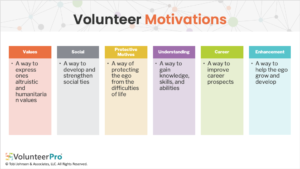The Motivation to Volunteer: Lessons from the Chilean Mine Tragedy
After over a year of lockdown or severely reduced volunteer activity due to the COVID-19 virus, we might be tempted to assume that the motivation to volunteer is waning rapidly.
After so much societal discord, conflict, and an ever-present existential threat, we might expect that everyone would simply want to withdraw from the world.
But it turns out that humans are much more resilient than that. When faced with adversity, we tend to figure out a way and get on with it.
This is partly because we are hard-wired to do so. Collaboration is part of our DNA, our internal operating system, and the urge to help others, given certain circumstances, can be quite is strong.
And we are not alone in that trait.
Back in the 1970s, founder of the field of sociobiology, biologist Edward O. Wilson studied and documented examples of “helping” behavior within many animal and insect species, including ants. He argued that prosocial behavior is a preprogrammed biological function in animals and humans, rather than solely a function of nurtured or learned actions.
Recent research shows that even plants have been documented as exhibiting prosocial and even “rescuing” behavior. Researchers have discovered that trees are connected through webs of fungi and will send nutrients, as well as chemical and electrical signals, to one another and that forests are more akin to a network of organisms. In other words, trees “talk to” and support one another.
For more on how trees communicate with one another and the implications for humans, check out the documentary “Intelligent Trees.” It’s a fascinating look at the wisdom of biology at work.
It makes sense, doesn’t it?
For any species to survive, it must rely on others. The word is full of dangers, and the only way to overcome them is by working in solidarity with others. This ability to partner has literally kept our race alive.
Human Tragedy and Lessons About the Motivation to Volunteer
The specific ways our urge to help others manifests itself has some valuable lessons for those who hope to tap the true depth of human nature, namely leaders of volunteers.
One such lesson comes from an unlikely source, a mine collapse in South America that occurred over a decade ago, in the news known as the Chilean Mining Accident.
Do you remember where you were when it happened?
For two full days, our household was transfixed by the (now successful) efforts of the Chilean authorities to rescue 33 miners, trapped for 69 days underground in Copiapo. Even as observers, our instinct to “help” by keeping vigil was strong, as millions watched the rescue play out around the world.
We were compelled to watch not just the nightly news recap, but also the ongoing news stream. We were so compelled, in fact, that we stayed up late into the night, I tracked it over the following day, and we kept vigil to the bitter end as the last brave rescue worker made his way to freedom.
And we weren’t alone. Millions of people around the world followed the story both on TV and the internet. So, what motivated such a strong compulsion? Does this event have any lessons for nonprofits and how we connect with our audiences?
Why We Were Watching
I believe the compulsion to watch was deeply ingrained in our biology. Partly, because we felt some sense of solidarity and need to support by keeping vigil. But there was more, something about how we as human beings react to information we receive.
In the case of nonprofits, our job is to get people to react — to donate, volunteer, change behavior, support our cause, etc. So, what could we learn here?
Emotion More Than Intellect
We also watched because the experience was laden with emotion, the most powerful driver of human action.
A few months earlier, I had sat in on a talk by Duke Professor & Behavior Economist Dan Ariely (writer of “The Upside of Irrationality” & “Predictably Irrational”). His research, and that of others, gives us insightful clues about how to engage and motivate potential supporters.
According to the research, we make 95% of our decisions based on our emotions versus our intellect. Emotion is a much more powerful driver than reason.
In fact, statistical information has a negative impact on action. In addition, we care more when we hear the story of one person versus the plight of millions. In other words, the more lives are affected, the less we care.
To watch an archived recording of Dan Ariely’s fascinating presentation for Network for Good. click here.
So, it makes sense to appeal to emotions when we communicate with volunteers. So, why do we always lead with statistics and facts?
The Power of Storytelling
In addition, the Chilean mine tragedy affected 33 men. not just one. Was the sheer number of people involved the reason it affected us so powerfully?
I suspect it had more to do with the power of storytelling.
When we hear a story, according to Roger Dooley, author of the Neuromarketing blog, we not only empathize, the appropriate parts of our brains are activated. We experience the story as if we were there.
In some ways, stories bring us back to childhood and the stories we may have been told and read to as children. When we hear the words “once upon a time,” that cues us that a story is about to start, and we immediately settle in to listen.
In Chile, through the power of multiple camera angles, above and below the surface, we were able to closely follow an unfolding story as a global community. The whole world tracked the progress of each miner as he entered the escape pod and when he exited the mine shaft. In a sense, we could travel with each one of them on their journey to freedom…and we did so in real time, virtually becoming part of the story.
How can we use storytelling as a powerful tool to engage supporters, even when we are not near one another?
Individuals, Not Statistics
In addition, we received individual information on each miner, their age, experience, role on the team, marital status, and who would be waiting up top to greet them.
And, as they joyfully embraced their family and rescuers, we experienced the moment, empathizing and imagining ourselves in their shoes. (It brought tears to my eyes every time, without fail.)
We were ignited by emotion, not because we heard statistics on the number of miners who have experienced similar tragedies, the rescue rates, the number of tons of material they hauled out every year, or the profits the company earned.
We cared because we felt an emotional connection to their individual stories.
How can we share the individual stories of volunteers and those they serve? What impact might it have on others who hear them?
We Admire Their Tribe
In his talk, researcher Dan Ariely contended that “we are creatures of narrative, stories, and belonging.”
He discussed the instinct in humans to herd, that people strive to be part of the whole. In the case of the miners, we aspired to be better human beings. We were inspired by their courage. We admired the strength of their tribe. More, perhaps, than we’ve admired anything in a long time.
How can we live our values and inspire supporters during the good times, but also the most difficult?
What Can We Do at Home?
So, how can we be led by the miners’ example and do good in our worlds? By what means will we ignite the emotions of our potential supporters? What stories can we share that will resonate with the public? And what are we doing that turns people away?
Even through a year of struggle and strife, we are lucky. Our organizations help people change their lives every day, maybe not as profoundly as a mine rescue, but valuable work, nonetheless.
But, if we are hindered by our ability to go about business because we need to keep others safe, how does that impact our mindset as well as the perspectives of others? If we wish to keep supporters connected, and don’t have assignments available for flexing our “prosocial muscles” through volunteering, what’s the alternative?
How can we continue to make progress and share it with the rest of the world in a way that really resonates?
The Motivation to Volunteer: Turns Out Volunteers Have Motives
Inside the VolunteerPro membership community, we teach a lot about the six functional motivations of volunteers, and how they can be applied to a variety of volunteer maangement actvities because they have been studied and validated extensively.
Like the Chilean mine accident, they have much to teach us about human motivation and behavior.
This research shows that volunteers are driven by hearts and minds as well as instinct.
It turns out that volunteers are seeking satisfaction or achievement of personal goals in six key areas. If they believe that a volunteer opportunity will satisfy one more of these, they will more likely respond to a call to action or continue volunteering.
- Values – where the volunteer sees participation as an opportunity to meaningfully serve others
- Career – participant views the opportunity as facilitating advancement & networking in their industry or field of work
- Social – in which the participant receives a measure of acceptance & acknowledgment from peers
- Understanding – the volunteer gains knowledge or insight from the experience that would be hard to come by otherwise
- Protective Motives – being a participant ensures they’ll be in emotionally supportive settings
- Enhancement – volunteerism promotes leadership development and their perception of power
Researchers have found that people are more purposeful than you might think and that different volunteers, who may even be working in the same role, might also have different primary reasons for doing so.
In addition, volunteers are often motivated by more than one need or goal, rather than a singular purpose, and that they may not even be completely aware of what is driving their prosocial behavior.
Why does it matter? In the end, positive organizational outcomes will depend on the matching of needs and goals of the volunteer to those of the organization and the opportunity offered. The quality of this match will impact volunteer recruitment, satisfaction, and retention.
So, how do you know what needs your supporters hope to satisfy through volunteerism? You simply ask them. You can do this through surveys, interviews, or group self-reflection and sharing activities.
Chances are, you already suspect the key reasons. Most often, values play a key role. But it’s also important to dig deeper to better understand the top 2-3 motivations to volunteer of your team as a whole.
Then, you can begin to design volunteer support and appreciation activities, as well as highly-focused volunteer recruitment messaging, that will truly resonate with supporters who are more likely to not only be attracted to your opportunities but also will find them fulfilling.
For more on how to pinpoint the primary motivations on your team, check out See: Gil Clary and Mark Snyder, The Functional Approach to Volunteers’ Motivations.









